At the start of the 1920s Sibelius wrote Hymn of the Earth for the choir Suomen Laulu and orchestrated Valse lyrique. He was now suffering from a tremor in his hands, an ailment that ran in the Sibelius family and which got worse with age. He drank wine to reduce the trembling and to make it easier to write musical manuscripts.
The composer was annoyed by a genealogical report which had been published in the press and which crushed his hopes of proving an aristocratic ancestry. Sibelius knew that Aino was descended from noble families on both her father's and her mother's side, and he had a somewhat absurd complex regarding his own origins.
On 16th February 1920, Sibelius along with the poet Eino Leino, Robert Kajanus, Eero Järnefelt, Pekka Halonen and some other members of the Kalevala Society, celebrated until the early hours. During the evening the composer excelled himself by displaying his
"noble" toes on the table and boasting that his family had not done manual work for several generations. Leino, who was very drunk, mocked Sibelius's pretensions:
"You, Sibelius, are a rococo figure, descended from the peasantry of Häme," the poet scoffed. The two adversaries almost came to blows at this point.
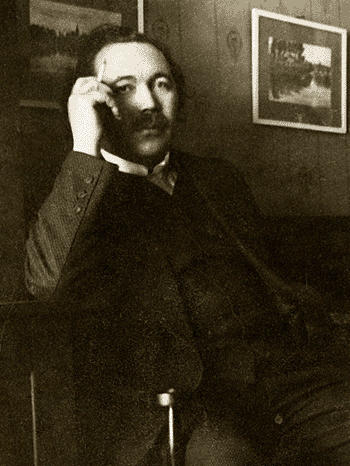
Eino Leino (1878-1926)
Sibelius also managed to compose: in the summer he conducted his works in several concerts at Finland's first industrial fair. One of his choral singers, Armi Klemetti, considered Sibelius to be easier to follow as a conductor than Robert Kajanus, whose gestures were vaguer and more
"floating".
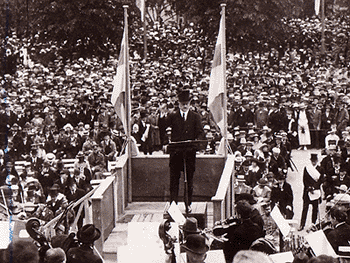
Jean Sibelius as a conductor at the opening of the Industrial Fair in the summer of 1920.
In the autumn, the Eastman School of Music in the United States offered Sibelius a professorship, and Rosa Newmarch passed on Henry Wood's request to have Sibelius in London as a guest conductor. Sibelius accepted Newmarch's invitation and for a long time also considered the offer from the United States.
On 8th December 1920, the tenor Wäinö Sola brought to Ainola a donation of 63,000 marks (about 19,500 euros today)
"from Finnish businesses" to honour Sibelius's 55th birthday. Sibelius's burden of debt had already been lightened as a consequence of the inflation that had occurred during the war. Now it was lightened even more, although Sibelius spent part of the money on a week of celebrations in Helsinki.
"A week in Helsinki and now terrible pangs of remorse at home. I no longer understand myself. Could I give up this boozing? It always remains just a pious hope," he wrote in his diary on the 18th December.
In January 1921, Sibelius travelled to Berlin to negotiate adjustments for inflation with Breitkopf & Härtel. The war had taken such a toll on the German publisher's resources that in the 1920s Sibelius sold some of his great works to the Danish publisher Hansen, and smaller works to English and American publishers.
The journey continued to Britain. During the trip, which lasted over a month, he conducted several concerts in London as well as in Bournemouth, Birmingham and Manchester. The repertoire of the tour included the fourth and fifth symphonies, The Oceanides and of course favourite pieces such as Finlandia and Valse triste. According to Rosa Newmarch, Sibelius lived
"quite sensibly" during the tour and conducted excellently. But thereafter the composer had no need to return to Britain to conduct his work: they were now a standard part of the orchestral repertoire.
The tour continued to Norway. In Bergen, Sibelius conducted his second symphony and Valse triste and celebrated for a couple of days and nights. In Kristiania he met his old friend, the author Knut Hamsun, but lack of sleep began to tell.
"The years have left their mark on both of us, damn it, and we are not as lively as we used to be," Sibelius observed in surprise.
Sibelius conducted three concerts, each a sell-out, and he met King Haakon and other dignitaries. Fatigue took its toll, and Aftonposten's Hjalmar Borgström noted that Halvorsen and Schnéevoigt had conducted the first symphony better. But the compositions themselves - including The Oceanides and even Valse lyrique - were praised rapturously. There was one more matinée concert, and then Sibelius returned home at the beginning of April.
On his return Sibelius became the figurehead of the first Nordic Music Days in Helsinki. The Norwegian composer Sverre Jordan wrote admiringly of the fame of the national hero in Helsinki:
"When we walked the streets, people took off their hats as if before a king." At the opening concert, Sibelius successfully conducted Lemminkäinen's Return, but the composer's nerves affected his conducting of the fifth symphony in the final concert, which did not go well.
The autumn passed in the familiar pattern of alternate concerts and binge-drinking, followed by weeks of composition. During this time his fame was growing abroad: Herman Scherchen conducted the fourth symphony in Leipzig, Busoni conducted the fifth symphony brilliantly in Berlin, and Leopold Stokowski conducted the same work in the United States.
At the start of 1922 the cyclical pattern continued. In January he completed Valse chevaleresque, which was a sort of representation of Sibelius's drinking-and-partying lifestyle. Sibelius's headaches were not caused merely by his drinking: he bought glasses for himself at Nissens on the 30th January. He was unwilling to wear them for photographs.
On 3rd May 1920, he heard that his brother Christian was incurably ill. It was a hard blow, and Sibelius was not much comforted by the fact that his Scaramouche, written almost ten years previously, finally had its premiere in Copenhagen. The critics praised music as being
"sweet and strange".
Christian passed away on the 2nd July.
"He was a wonderful person and brother," Sibelius wrote in his diary.
In August 1922, a group of influential Finns decided to revive Freemasonry in Finland. Sibelius, too, joined the organisation and promised to compose ritual music. His most active period as a Freemason lasted little more than a year or two, but in 1927 Sibelius composed excellent ritual music for the Masons, and he maintained contacts with the organisation until his death.
In September 1922 Sibelius started to make progress with his sixth symphony, which he had been drafting for a long time. About six months later, in February 1923, the new masterpiece was performed for the first time. This lyrical and subtle work both perplexed and delighted the audience and critics.
"The sixth symphony is more delicate, smaller in scale and gentler. The fifth is an exuberant jubilee, the sixth is pure idyll," wrote Evert Katila.
In an oddly contrasting manner, Sibelius also conducted some his lightest orchestral works in the same concert, coquettishly swaying his hips. The critics thought that Valse chevaleresque, Suite champêtre and Suite caractéristique showed influences from jazz and shimmy, and also from Tchaikovsky.
After the première, Sibelius and his wife went on a tour. This was the first time that he ventured to conduct in Stockholm, where the critic Wilhelm Peterson-Berger had from time to time made harsh remarks about his compositions.
Now Peterson-Berger praised Sibelius as an interpreter of En Saga, The Lover and The Swan of Tuonela, but he thought that on this occasion the finale of the second symphony was performed half-heartedly. Another critic William Seymer wrote that Sibelius fired up the orchestra towards
"great achievements" and the most intensive playing of all time. Aino Sibelius recollected later how the street was full of people after the concert, and how the musicians accompanied the composer shouting
"maestro, maestro".
The tour continued to Rome. Sibelius explained to a local journalist that his music did not come from Finnish folk songs:
"I have composed a great deal in the manner of folk tunes; but those tunes have always come from my own brain, or rather from my burning Finnish heart. I have drawn from the poetry and tales of my homeland and I have then sung my song in my own way, often enriching my soul with Kalevala, which is an inexhaustible source for an unspoilt Finnish artist," Sibelius said.
The visit was given a great deal of space in Roman newspapers, but the composer was nervous, and the concert was only moderately successful. Il Mondo criticised the choice of repertoire and said that the concert tired the audience. The critic believed that En Saga and The Swan of Tuonela would have gone down better with the Italians than Finlandia, Lemminkäinen's Return and the Pelléas and Mélisande suite. The second symphony was praised by Il Mondo, but L'Epoca considered it only a moderately interesting musical mosaic.
After the concerts Sibelius went with his wife to Capri for a week. After the holiday the tour continued to Gothenburg, in Sweden. The first concert was a complete success. Sibelius conducted the fifth and sixth symphonies and Pohjola's Daughter. The critics were in ecstasy.
"Papa is brilliant," wrote Aino to her daughters after pleasant evening occasion.
The works for rehearsal the following morning were The Lover, The Oceanides and the second symphony. After the rehearsal Sibelius went into town to relax. He was not found until after eight pm - at a restaurant, tucking into oysters and drinking champagne. The intoxicated Sibelius was hurried back to the concert hall, and he got onto the rostrum in time - but he interrupted the performance after a few beats, apparently thinking that it was a rehearsal.
His wife was ashamed.
"Everything was chaos in my ears, I was in a state of mortal terror," Aino Sibelius said later. But Sibelius managed to pull himself together, and the concert continued without further interruptions. There was a tremendous storm of applause, and the orchestral musicians were left with a good memory of him.
"Among those modern composers who can conduct an orchestra, Jean Sibelius unquestionably deserves a place of honour," observed Gustaf Gille.
"I have seldom experienced such extreme richness of detail as when Jean Sibelius is conducting."
After the final concert, Sibelius smashed a bottle of whisky that he found in his breast pocket on the stairs of the concert hall. But the high praise of the critics perhaps went some way to calming him down.
Sibelius continued conducting in Finland, on a visit to Vyborg. He was treated as a national hero, and the first violinist, Sulo Aro, did not wash his hands for a long time after he had shaken hands with the
"master".
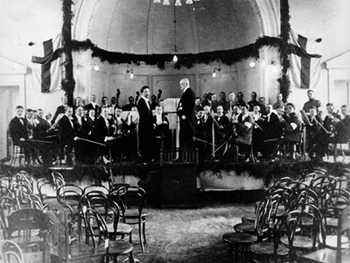
Jean Sibelius shaking hands with Boris Sirpo, the conductor of the Vyborg orchestra, after the concert in 1923. Sirpo had rehearsed the programme; the composer himself conducted the concert.
On returning from Vyborg, Sibelius concentrated on writing the seventh symphony. The work progressed during the autumn, although he was continuing to sip alcohol to steady his shaking hands. Although Finland had a prohibition law, Sibelius received alcohol as a prescription drug from his doctor acquaintances. The drugs included spirits, medical brandy, medical wine and various quality brands that were obtainable from pharmacies.
"My life is definitely finished. If just once I'm in a merry mood and take a glass, I have to suffer from it for a long time afterwards," Sibelius wrote on the 3rd October. Yet one month later life was again
"rich and deep" according to the diary. He worked a lot, and the Kordelin Foundation gave him an honorary award equivalent to about 25,000 euros in today's money.
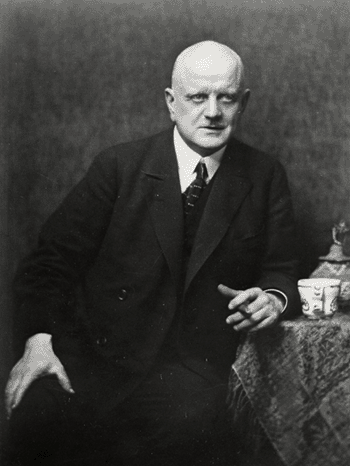
Jean Sibelius in 1923
At the same time his popularity was increasing rapidly in the United States. Pierre Monteux had conducted the fifth symphony in Boston with great success. In the same year Paul Cherkassky, who had moved to the Boston Symphony Orchestra, wrote to Robert Kajanus that the first symphony and the Berceuse (which Cherkassky had played as an encore) had pleased the audience. Cherkassky also mentioned that Boston had chosen Serge Koussevitzky as its next conductor. It was in Boston that Koussevitzky was to become one of the great Sibelius interpreters.
The beginning of the year 1924 Sibelius dedicated to his seventh symphony - and to alcohol.
"Alcohol to intoxicate nerves + mind. How tremendously tragic is the fate of an aging composer. The work doesn't flow as fast as before and self-criticism is increasing to the point of impossibility," he wrote in his diary on the 6th
January.
Aino Sibelius remembered the difficult times, when his husband had been on the verge of alcoholism during the years 1903-1904. Aino wrote on a slip of paper that she would no longer follow her husband on his concert tours, as she could not bear to see him conducting in a drunken state. Neither could she understand composing with the help of
"artificial inspiration".
"You must change or it will be the end of you," Aino wrote.
"Try to get rid of whatever it is that pulls you down there. Haven't you seen where it is taking you. Even if you complete a work or two, they are nothing compared with what you could achieve."
Aino Sibelius was wrong, in part. Sibelius was indeed able to complete a work which was the culmination of his career as a composer. The seventh symphony was completed in March, and the alcohol had apparently steadied the hands enough for him to get the work down on paper. The actual brainwork had of course - judging by the result - taken place without alcohol.
Sibelius conducted the first public performance of his symphony in Stockholm at the end of March, still under the name Fantasia sinfonica I. Because of ice on the Baltic, Sibelius's voyage was delayed, and the violin concerto had to be performed at the first concert without a rehearsal. Julius Rutström was the soloist, and Sibelius later had nightmares about the situation. Nevertheless, the first public performance of the symphony was a success.
In the summer of 1924 Sibelius became acquainted with his daughter Margareta's friend and future husband, Jussi Blomstedt (later Jalas), and the pianist Martti Similä. Both became conductors and Sibelius's musical confidants. He could now take on the authoritative role of a senior composer. This he polished into a perfect mix of authority and warm hospitality during the following decades.
In August 1924 Sibelius heard of the death of Ferruccio Busoni. To counterbalance this sad news he could celebrate his daughter's wedding on the 30th August, when Katarina, aged 21, married the lawyer Eero Ilves, aged 37. Ilves was building a career as a bank manager and he took care of Sibelius's finances and taxation affairs till the 1940s.
"Kai's wonderful wedding. Everybody is happy," Sibelius wrote in his diary on the 5th September. During these days Heidi, too, started her school in Helsinki. Now none of the daughters was living in Ainola during the week.
On the 23rd September, Sibelius went on a concert tour to Copenhagen, alone. From the Hotel d'Angleterre he wrote tender love letters to his wife, who was no longer accompanying him on concert tours. The letters to Adolf Paul were different.
"I need a lot of money. Here in Copenhagen I only drink champagne," Sibelius informed him. He met the Danish royal family and received the Knight Commander's Cross of the Order of Dannebrog.
Fantasia sinfonica I was well received, and the reviews were respectful. Sibelius was pleased. He visited Malmö and continued to give concerts in Copenhagen. He performed to a full house in five concerts. This
"beat all records" according to the newspaper Politiken.
His hectic life was putting a strain on his heart.
"I have to give up conducting, because I've reached a point when I have to make special efforts to calm my nerves, something that my doctor, too, was well aware of," he wrote to Aino on the 9th October.
The rest of the year was spent writing small pieces. According to the diary, alcohol was now Sibelius's only friend.
In early 1925 Sibelius was a frequent customer of the restaurants of Helsinki, for his work was not progressing. The depth of the crisis should not be exaggerated. His living habits were healthier than those of his neighbour, the poet Eino Leino, who had been destroying himself with drink, and who died only a year later. Sibelius's life in Ainola was held together by his wife and his family life. Leino did not have this kind of safety net.
In May 1925 the publisher Wilhelm Hansen and the Danish Royal Theatre both approached Sibelius with the same objective: they needed Sibelius's music for a production of The Tempest. The composer started to work on his last and greatest incidental music. The feverish period of work ended at the beginning of autumn, but the premiere of the The Tempest was postponed until March 1926, and the composer realised that he had been hurrying unnecessarily.
During the rest of the year Sibelius wrote small pieces. He was nervous about his 60th birthday celebration, which became a national event. Sibelius spent his birthday in Helsinki at the home of his daughter Eva Paloheimo, refusing to appear in public.
The birthday donations he now received finally set Sibelius free from economic problems. A nationwide collection produced the remarkable sum of 275,000 marks (over 65,000 euros today), more than half of which was for the composer's own personal use. His pension was raised to 100,000 marks a year (about 24,000 euros today). The mixed-voice choirs of Finland purchased almost a hectare of land around the estate of Ainola and gave him that as a birthday present.
The copyright system was now better developed, and Sibelius had begun to receive decent royalties from the German copyright organisation, GEMA. As inflation had eaten away a major part of the old debts, the composer's financial situation was now on a more satisfactory footing.
Jubilee concerts of his music were being given around the world. Leopold Stokowski conducted the first symphony at a concert of the Philadelphia Orchestra in New York. The New York Times critic Olin Downes was enthusiastic about the Finnish composer and urged orchestras to play his music.
At the beginning of 1926 the New York conductor Walter Damrosch commissioned a symphonic poem to last 15-20 minutes. Sibelius answered in the affirmative, and this marked the beginning of the composition of Tapiola. Sibelius decided to use his birthday donations to travel alone to Rome in March, in order to write the work.
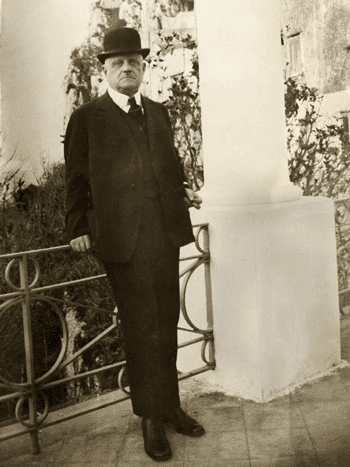
Jean Sibelius on Capri in 1926.
As well as working, he spent a holiday on Capri with his friend Walter von Konow. The writing of Tapiola was started, and the composer returned home satisfied. Now he could continue his work and keep an eye on the repairs at Ainola. During the summer, the sauna was taken to pieces and rebuilt, and a gate was placed on its present site, on the new boundary of the enlarged estate. Since the value of their property finally exceeded the debts, the spouses had reason to draw up a mutual will. It was legally confirmed on the 19th July.
During the summer Sibelius completed Väinö's Song for the Sortavala Song Festival. In his diary Sibelius cursed such
"commissioned works", but he managed to complete Tapiola in the autumn.
In autumn 1926 Sibelius performed for the last time as a conductor outside Finland. He conducted in Copenhagen, but the half-hearted reception of the fifth symphony hurt him. Of course, Finlandia and Valse triste charmed the audience at the end of the concert. The reviews were mostly favourable, and on returning home Sibelius quickly made the final corrections to the manuscript of Tapiola. Damrosch received the score in November.
On 2nd December 1926 Sibelius participated in the festivities for Robert Kajanus's 70th birthday. The core trio of the Symposion circle were struck on seeing each other's lined faces and bald heads. In their speeches, Gallen-Kallela and Kajanus looked back on the 1890s with nostalgia.
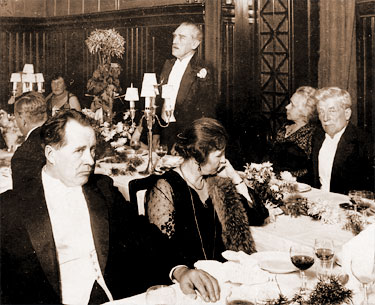
The 70-year-old Robert Kajanus speaking at his birthday celebration in December 1926.
At the end of the year Sibelius was pleased to read good reviews of his works in the newspapers of London and Boston. On Boxing Day he met with a slight setback when Damrosch performed Tapiola for the first time in New York. Even Olin Downes, the enthusiastic Sibelian from the New York Times, was perplexed, although he wrote an appreciative review of the work. Tapiola gained even less understanding from the New York Herald Tribune's Lawrence Gilman.
Early in 1927 Sibelius completed his Freemasonry Ritual Music, which he had been promising for a long time. The first public performance was on the 12th January. Sibelius presented the manuscript for the Finland lodge to use in internal activities, and other Finnish lodges were also given the right to use the music at their meetings. The Ritual Music contained eight movements, and the composer added to it later.
At the end of January 1927 Sibelius went to Paris with Aino. The last bills had now been paid, so the composer could for the first time travel without debt worries.
"I have now everything in order financially, and I can concentrate on what I want. Isn't it wonderful," the composer wrote.
After the trip to Paris the composer buried himself in Ainola, and his wife blamed him for not keeping in touch with
his friends. "The loneliness is driving me crazy. Not even my wife speaks to me now," Sibelius wrote somewhat unfairly in his diary.
"To be able to live at all I have to consume alcohol. Wine or Whisky! This is what all this is about. Run down, lonely, all my real friends are dead. Unable to work. If only I could find a solution," he wrote pathetically in his diary on the 8th May. Nevertheless, only two days later he was playing four-hand piano pieces with his wife, and working at full blast with the orchestral suites of The Tempest! Aino had her hands full with the strong mood swings of her husband.
"Papa had the kind of disposition that led him to calm down quite suddenly," his daughter Margareta recollected later.
In the summer of 1927, Sibelius was somewhat reluctantly putting the finishing touches to the orchestral suites of the incidental music for The Tempest.
"The Tempest suites are tormenting me to death. It feels like having to do one's homework again," Sibelius wrote on the 17th May.
The pages of Sibelius's diary during the summer also record an intense personal struggle. The notes are brief, and their intention is clear: Sibelius had decided to banish his craving for drink. He was on the verge of alcoholism, and every day was a struggle against the destructive substance. The notes
"S. A." (sine alcohol, without alcohol) are sometimes interrupted by
"one whisky", and sometimes by a day's drinking.
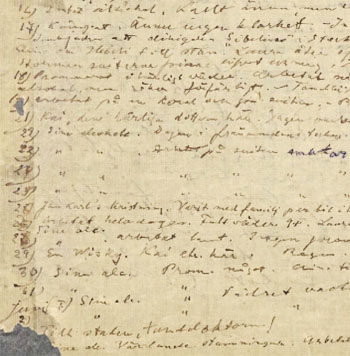
Excerpt from the diary from June 1927.
Nevertheless, the struggle ended in victory. Sibelius did not become a total abstainer, but he managed to improve his drinking habits significantly and to save his health.
On the 22nd June he could write: "My alcohol consumption is very moderate," and in August he sent the second suite of The Tempest to Hansen. He had thus completed the last significant new orchestral work that he ever was to send to a publisher.
At the same time, in early August, the Finnish Parliament signed a law concerning copyright for intellectual products. Now that the law had been brought up to date, Finland could join the Berne Convention of 1928. Sibelius's royalties for the performance of his works started to be collected more efficiently. This marked the beginning of a development which made him a wealthy man. But the situation did not lead to new, major works for publication. One may wonder whether in the earlier years it was actually the financial pressures that helped the composer to create new masterpieces.
Of course, at the beginning of September 1927, Sibelius could not foresee this development. He was already planning a new work, presumably the eighth symphony.

